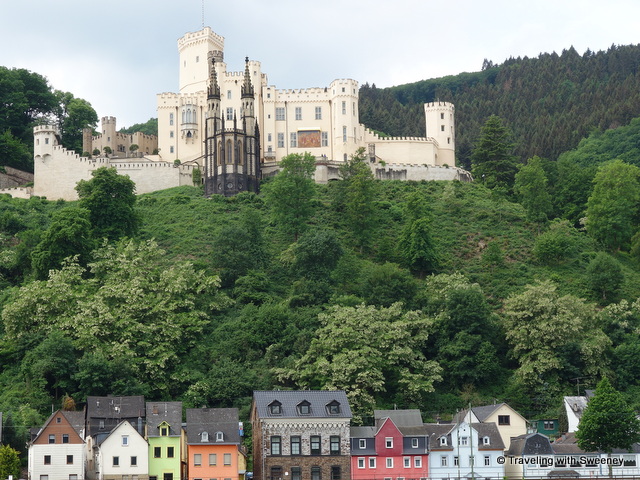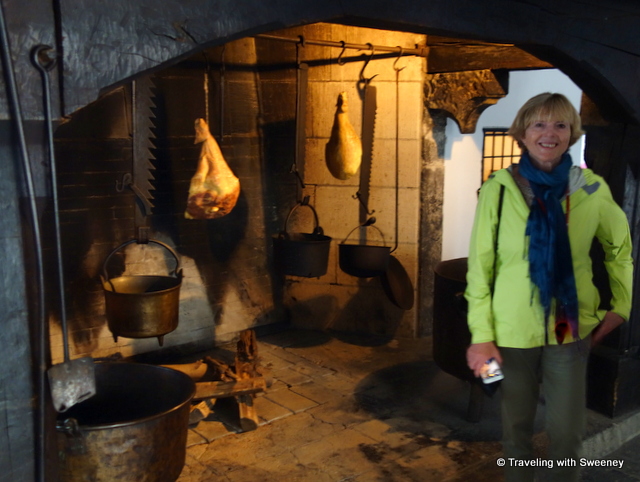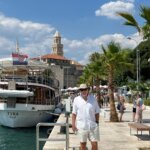The captivating castles of the Upper Middle Rhine Valley
Our Viking cruise along the Middle Rhine River in Germany provided spectacular vistas of castles and fortresses — pretty, fairytale-like, majestic, imposing, some showing battle scars and effects of old age. A 65km scenic stretch of the Upper Middle Rhine Valley between Bingen/Rüdesheim and Koblenz, designated a UNESCO World Heritage Site in 2002, showcases Rhine River castles perched on hillsides above riverside villages amid terraced vineyards.
It’s easy to see why the Middle Rhine River Valley was inspiration for the 19th-century writers and artists, including Goethe and Byron, and why it was one of Germany’s first tourist destinations with famous visitors, such as Mark Twain who wrote about the area in A Tramp Abroad.
Let’s do some cruising and enjoy these Rhine River castles
Although the weather was beautifully clear and sunny though unseasonably chilly during our cruise in May, Mr. TWS and I (along with many other Viking passengers) took to the upper deck and bow of the Viking Tialfi to get the best views along the way between Rüdesheim and Koblenz. While sitting on the bow immersed in the beautiful sights, servers came around with warm blankets and hot chocolate to make us all feel cozy. So I sat back, relaxed, and enjoyed the scenery of the Rhine River castles and villages described using the PA system by Morgan Van Selman, our cruise Program Director.
With so many landmarks, charming towns, and pretty sights to see along the way, I’ve limited this series of photos and bits of historical information to some of the highlights.
Rheinstein Castle
It’s amazing to see a castle like Rheinstein built into a sheer rocky cliffside. The current Rheinstein Castle was built in the 19th century on the site of the original castle built in 900AD. Notably, it has been the home of Emperor Rudolph von Habsburg from 1282 through 1286, leased by the Archbishops of Mainz, and home to the Royal Prince of Prussia.
Reichenstein Castle
Vacationers at the campground in Trechtingshausen enjoy a gorgeous position below Reichenstein Castle. This is an enormous neo-Gothic castle built in the 11th century and originally owned by one of the area’s notorious robber barons. It was left to decay in the 16th century but rebuilt throughout the 19th century.
Fürstenberg Castle ruins
Above the village of Rheindiebach are the ruins of Fürstenberg Castle, built in 1219 by the Archbishop of Cologne to protect his estate and to act as a toll station. You have to use your imagination to envision the nobility of life at the castle since it was destroyed during the War of the Palatine Succession in the 17th century.
Stahleck Castle
The 12th-century Stahleck Castle has changed hands from the diocese of Cologne to Emperor Barbarossa, to the emperor’s brother, to the Bavarian dynasty — all between 1135 and 1214. It was destroyed by the French in 1689. The castle was reconstructed during the early to mid-20th century and is currently a youth hostel.
Gutenfels Castle and Pfalzgrafenstein Toll Station
The eye-catching Pfalzgrafenstein was built in 1327 and was a toll station until 1866. The castle was never destroyed and so is original construction. Its location on the small island in the Rhine was perfect for its purpose as a toll station.
Above Pfalzgrafenstein on the hillside is Gutenfels, a 13th century castle situated amid the lovely terraced vineyards. As many castles of the time, it was the scene of sieges and important historical events some as a result of this location as one of the shallowest spots on this section of the Rhine. For example, Prussian Field Marshal Blucher and his army in 1813 /1814 crossed the Rhine here on his way to France and the battle leading to the fall of Napoleon. This spot of the Rhine is also associated with a legend about the fleur-de-lis, an important symbol of French nobility. Frankish King Clovis in the late 5th century fleeing an enemy saw a wild yellow iris in the river, which he correctly interpreted to mean there was shallow water here. He later adopted the yellow iris as an important symbol on his herald which according to the legend evolved to the fleur-de-lis.
Schönburg Castle
Wouldn’t you love to stay in this castle’s hotel? Above the town of Oberwesel stands Schönburg Castle, aptly-named as “schön” means “beautiful” in German. The 19th-century German poet, Ferdinand Freiligrath, referred to it as “the most beautiful refuge of the Rhine romanticism”. Built in the 12th century, it was destroyed in 1689 (like several other castles in the area), and rebuilt in 1885.
Rheinfels Fortress
Rheinfels Fortress is the largest castle overlooking this section of the Rhine located high on its west bank, though much of the castle is ruins (destroyed by the French in 1749.) Originally built to protect the tax collectors beginning in 1245 by Count Diether V von Katzenelnbogen, it was expanded to a fortress with an area almost five times as large as its current footprint and served as the residence of the counts.
This area and slightly north along the Rhine seemed an area to target for future visits exploring on land with beautiful towns such as Boppard just before the big bend of the Rhine. Near Boppard is a chairlift that provides accessibility to some of the most beautiful views of the Rhine, including a vantage point where the twists in the Rhine cause the appearance of four individual lakes.
Katz Castle
Across the Rhine from Rheinfels Castle above the town of St. Goarshausen, is Katz Castle, built by Count Wilhelm II of Katzenelnbogen in the 14th century to protect Rheinfels Castle. Katz Castle was a bastion and military base as its position high on the ridge protected it from attacks from below. However, there were many heritage disputes between Katz and Rheinfels castles, destroying and rebuilding the castle several times before Napoleon actually destroyed it in 1806. Later, the castle was reconstructed closely to the original design and is now the Katz Hotel.
An important landmark and sight in the river here which is the inspiration for several legends, songs, and other writing is Loreli, a 132-meter-high slate rock. The river is deep and narrow here with a fast current that causes a gurgling sound. The treacherous spot had been the site of many boating accidents over the years which led to the primary legend which is of a siren-like beauty who lured sailors to calamity with her song.
Maus Castle
And where there is a “Katz”, there’s a “Maus”.
Just a short distance north of Katz Castle on another hill is Maus Castle built between 1353-1388 to protect the territory of Archbishop Balduin. Folklore says it got its name from the Katzenelnbogens who ridiculed during its construction that the cat (Katz Castle) would eat the mouse.
Sterrenberg and Liebenstein Castle
A 16th-century legend says that Sterrenberg Castle and the adjacent Liebenstein Castle are called the “Hostile Brothers” because of the disputes between the castle owners, two brothers. But history seems to show that Liebenstein was built to shield Sterrenberg and there were no actual conflicts between the two.
Stolzenfels Palace
This beautiful romantic palace shines white high on the west bank of the Rhine. Originally built as a fortress in the 13th century, it was later used as a toll station. Destroyed in 1689 in the Palatinate War of Succession (also known as the Nine Years’ War), it was rebuilt by Prussian King Friedrich Wilhelm IV as a palace in 1823 and appears much the same today.
Ehrenbreitstein Fortress
An optional excursion on the Rhine Getaway cruise is a tour of Ehrenbreitstein, the imposing fortress known as the “Guard at the Rhine” towering over the Rhine in Koblenz. This citadel was built in the 19th century (on the site of the original 12th century fortress) as protection against the French. This tour was at the same time as the Marksburg tour so we missed it, but did take the opportunity to take the cable car from the dock across the river to the fortress entrance and back — just for the fun of it. We enjoyed the sweeping views of Koblenz, the Rhine, the Moselle, and the surrounding area from the cable car.
Marksburg Castle
At first glance of the 13th century Marksburg Castle from the bow of the Tialfi, I was taken by the fairytale beauty of its turrets and towers. Marksburg is the only castle on in the Rhine Valley that was never destroyed.
I’ve shared a few more photos of Marksburg Castle since a guided tour was included in our Rhine Getaway itinerary. On our tour of this remarkably well-preserved castle, we enjoyed a look at ancient artifacts in the kitchens, living quarters of nobility and servants, the citadel, and even the torture chamber with its disturbing devices. There is also an impressive collection of armor (shown below).
I enjoyed the beautiful art and decorative features throughout the living quarters including intricate tapestries and painted ornate ceilings.
Imagine cooking in this kitchen! I suppose it was a wonderful place to be working in the wintertime with a warm fire to keep you warm.
The scenic cruising of the Upper Middle Rhine river was one of many highlights of our Rhine Getaway cruise. Thanks to Viking River Cruises for hosting our castle cruising experience.
Castle cruising tips
Marksburg Castle tour tip: There is quite a lot of walking involved, including stairs and uphill walkways.
Castles and fortresses footwear tip: When selecting the shoes to wear for castle tours, remember that you’ll most likely be encountering uneven cobblestone walkways and stairs. Wear shoes that are comfortable, supported, and safe! And yes, this cautionary message comes from previous personal experience.
Further information tip: Loreley Info has historical background on each of the castles and provides useful visiting information for those that are open to the public.























I usually think of Ireland and the UK when I think of castles but it certainly sounds as though Germany’s castles are just as impressive. Rheinstein Castle is especially pretty – That campground has got to have one of the best locations in Europe! What a beautiful journey this Viking cruise would be.
What a wonderful compilation of the castles along the Rhine River. I love not only the great photos, but the history lesson you have me on each of them. I imagine the campground beneath the castle would be an amazing place to stay with a great view.
Looks like medieval Germans got the memo about how it’s always good to occupy the high ground. We have yet to experience river cruising. It’s definitely on our proverbial bucket list.
Lovely story. There’s nothing more majestic than European castles. Your story reminded me of my Viking cruise….the only way to travel! I need to book another one ASAP.
Castles are among my fondest memories of travels along the Rhine…and it looks as though your Viking cruise delivered plenty of sterling castle views along the way! I especially like the photo of Stolzenfels Palace with those colorful houses below. Quite splendid.
Castle cruising on the Rhine looks like great fun! Thx for introducing me to this idea, Cathy.
What a wonderful cruise this must have been! I did visit many of the castles you mention a while back on a car “cruise” along the Rhine. We stayed the night at Rheinfels and enjoyed looking down at the river boats gliding by. That might have been the first time I ever saw a river boat.
What a fascinating experience to see these beautiful castles. It’s hard to imagine what life was like back then…. I’m just drooling at the thought of cooking in the Marksburg Castle kitchen. What a lovely cruise! 😉
Pingback: Meet the Cruisers: The Nice People You Meet on a River Cruise | Traveling with Sweeney
Pingback: UNESCO Treasures on the Rhine: Sites to Visit on a River Cruise | Traveling with Sweeney
Pingback: Romantic Europe: 10 Special Places in My Heart | Traveling with Sweeney